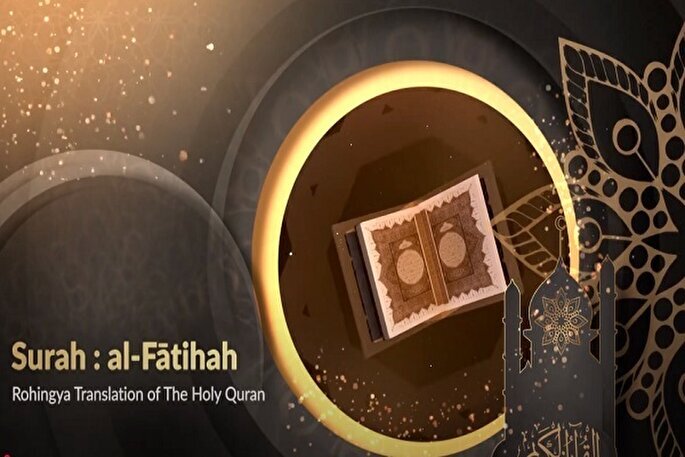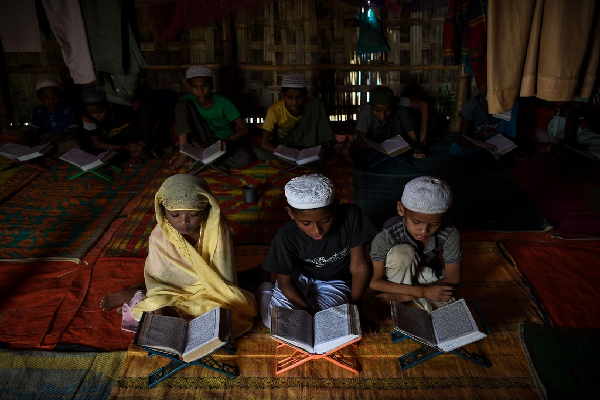Quran in Rohingya: A Translation to Revive A Suppressed Minority’s Language

The Rohingya are an Indo-Aryan, predominantly Muslim, ethnolinguistic group living in Rakhine State in western Myanmar. It is estimated that 1.4 million Rohingya lived in Myanmar before the 2017 genocide, when more than 740,000 of them fled to Bangladesh.
Before 1989, the state was known as Arakan, the historical name for the region that stretches along the northeastern coast of the Bay of Bengal and includes present-day Bangladesh. The military junta that came to power in 1988 changed the name of the province, deliberately adopting the name of a predominantly Buddhist ethnic group, Rakhine, as part of an effort to separate Myanmar from its Muslim-majority neighbor. This was part of a racist nation-building project and another step in a long history of attempts to erase the Rohingya from Myanmar’s history and society.
A targeted effort to erase the Rohingya
Since the first military junta came to power in 1962, the Rohingya have been systematically denied civil and political rights, on the grounds that they are not truly Burmese but rather Bangladeshi citizens and illegal immigrants to Myanmar. They have suffered from a lack of education, infrastructure, healthcare and economic development, all of which have been deliberately denied to them. The first wave of violent persecution led hundreds of thousands to seek refuge in Bangladesh in 1978, most of whom were later allowed to return under a repatriation agreement brokered by the United Nations.
Read More:
However, in 1982, Burma’s Nationality Act limited citizenship to only those “national races” explicitly mentioned in the bill, which did not include the Rohingya, rendering them stateless. Further state violence against the Rohingya occurred in 1991–1992 and, ultimately, in the largest and most systematic attempt to eradicate Myanmar’s Muslim population, from 2012 onwards, culminating in the “Rohingya crisis” in 2015. This coordinated campaign against the Rohingya was classified by the Office of the United Nations High Commissioner for Human Rights as “genocide” and a “crime against humanity”.
Some academics, analysts and political figures, including Nobel laureate and South African anti-apartheid activist Bishop Desmond Tutu, have compared the conditions faced by the Rohingya in Myanmar to apartheid. The latest mass displacement of Rohingya in 2017 prompted the International Criminal Court to investigate crimes against humanity and the International Court of Justice to consider the case as genocide.
Development of a Standard Rohingya Script
The Rohingya language is closely related to Chittagong Bengali, spoken in eastern Bangladesh, and more distantly related to Standard Bengali. As the Rohingya are largely a rural community with low social ties, their language is used more orally than in writing. During the colonial period, written communication was usually in English or Urdu, and since independence, in Burmese.
When Rohingya was written, a non-standard variant of the Perso-Arabic script was used, and this was the script that was used in 1975 to propose a standard Rohingya orthography. In 1985, a Rohingya scholar and Islamic teacher named Muhammad Hanif developed an independent script, partly inspired by Arabic, called the Hanif Rohingya script. In another development, in 1999, a Latin script adaptation specifically designed for Rohingya writing was proposed.
The addition of the Hanafi script to the Unicode standard in 2018 was a major milestone for Rohingyas who had been fighting against the erasure of their culture. As of 2019, there is also a virtual keyboard for the Hanafi script, and Google has created a Rohingya font. It is worth noting that the Hanafi script only came into being because Hanif was living in Bangladesh when it was developed, as the written use of the Rohingya language is banned in Myanmar. Seeing this attempt to eliminate the Rohingya language, Hanif was determined to fight it.
“If a people does not have their own written language, it is easier to say that you do not exist as an ethnic group and it is easier to suppress them,” he said.
Read More:
The fact that most Rohingya living in Myanmar, as well as those living in the harsh conditions of refugee camps, are deprived of formal education means that many instead turn to basic Islamic teachings. However, few Rohingya go beyond basic religious knowledge, and a refined scholarly tradition has never had a chance to emerge. In such a society, the role that Quran translations can play in preserving endangered cultures is all the more important.
Quran Translation Project for the Rohingya
In such circumstances, the Rohingya Quran Translation Project aimed to bridge the gap in knowledge about Islam and counter the suppression of the Rohingya language. The project was initiated by Qutub Shah, a Rohingya who is pursuing a PhD in Comparative Religions at the International Islamic University of Malaysia. He collaborated with Dakwah Corner Bookstore, a missionary publisher based in Petaling Jaya, a suburb of Kuala Lumpur that specializes in Islamic education in English. Since the Rohingya language is rarely used in writing and as a result few Rohingya have learned to read it, let alone in script, the team decided to take the unusual step of first providing an oral translation of the Quran in Rohingya before starting to produce a written translation.
So the translation team began by producing audio and video materials. In doing so, they used a number of Quranic commentaries and translations in English, Urdu, Bengali and Burmese published by the King Fahd Congregation in Medina. The Dekho Corner Bookstore has a branch in Mecca, which is reflected in the selection of these resources.
Work on the oral translation of the Quran began in early 2021 and was completed in August 2023. Users can choose from professional audio and video files that combine the recitation of the Arabic Quran with the oral translation in Rohingya. The project team used the recitation of Muhammad Ayub, a religious scholar who was born in Mecca to Rohingya refugee parents and later became the imam of Masjid al-Nabawi in Medina. So they aimed to create a connection with the Rohingya community even in the recitation. The translation is read by Qutb Shah, who was also the original translator. Audio and video files are available on the Rohingya Quran app for iOS and Android, as well as on the project’s website (https://rohingyaquran.com), YouTube, and various social media.
Quran Translation, a Way to Revive the Rohingya Language
Based on oral translation, a written version in Hanafi script is currently being produced, covering the first five Surahs so far. The translation team noted that they faced several challenges in implementing the project, the first of which is the history of oppression of the Rohingya language. They wrote: “Although the writing system evolved in the late 1970s, its popularity waned due to the systematic genocide of its speakers. Hence, there is no literature or intellectual works in the language, and it has become almost a semi-lifeless language. The language is used only for the needs of their daily lives. Writing was forbidden in their homeland, and those in exile struggled to survive and were influenced by the local languages. Many idioms disappeared, while many others were replaced by idioms from other languages.

Translating the Quran into this target language was perhaps the first attempt to translate such a text into Rohingya. The problem involves three aspects: translating words, sentences, and eloquence. In this regard, several people with linguistic, cultural, geographical, and religious expertise are consulted. Sometimes, several words, a phrase, or even a sentence are needed to translate certain words. It was a difficult task, but ultimately successful. It just took longer than expected.
Read More:
The translation is explanatory and includes interpretive additions, both for the linguistic reasons mentioned above and because of the translation team’s dogmatic approach to translating the Quran. They have invested a lot of energy in developing the technical infrastructure needed to typeset the Rohingya Quran, such as keyboard layout and font design. Dekho Corner Bookstore is currently fundraising to complete the project, with the aim of printing 2,000 copies and distributing them in Malaysia, Bangladesh and Saudi Arabia. Producing such a limited edition is an example of the challenge of translating the Quran into languages that are predominantly spoken, making the project team’s decision to produce professional audio and video files all the more innovative and important.
In marginalized Muslim-majority communities like the Rohingya, there is potential for a symbiosis between language projects, cultural preservation campaigns and efforts to promote and educate about Islam. The Rohingya Quran Project is only the latest example of this, but it is certainly one of the most impressive because of the care and professionalism with which it has been carried out. The use of up-to-date technology in it not only helps in the distribution of the Quran translation itself, but also in the development and standardization of the Rohingya language. This is a great example of how the current trend of translating the Quran into an increasing number of languages is playing an important role in preserving the world's linguistic diversity.
4299046



